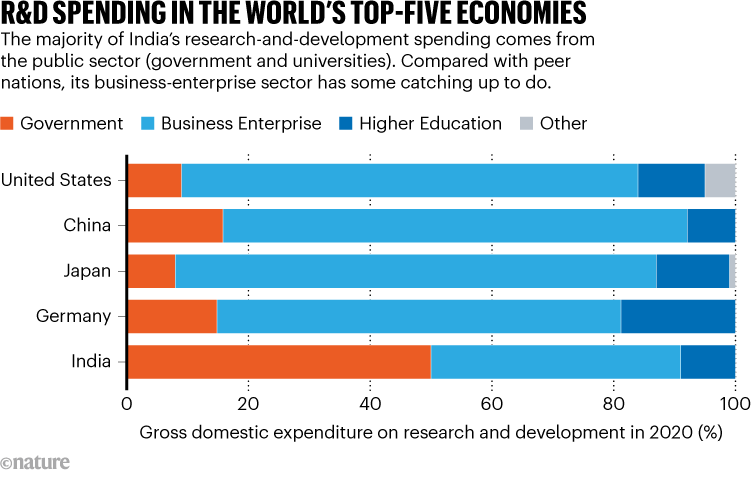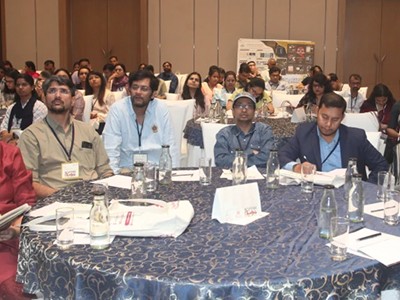
Last August, India became the fourth country ever to achieve a soft Moon landing.Credit: Kabir Jhangiani/NurPhoto/Getty
India’s general election begins this week. Nearly one billion voters are eligible to go to the polls in a marathon exercise, starting on 19 April and ending on 1 June.
Opinion polls are projecting that an alliance of parties led by the incumbent Bharatiya Janata Party will win a third consecutive term against an alliance of opposition parties led by the Indian National Congress. The winner will take charge of the world’s fifth-largest economy. According to projections, India could become the third-largest economy, behind China and the United States, by the end of the decade.
Along with being an economic power, India is also more than ready to take the next step towards becoming a science powerhouse. This is not yet a given, but it can happen. Researchers told Nature’s news team that basic research has been neglected by successive governments, and that a thriving research system needs much greater autonomy. In this editorial, we discuss a third aspect: how to bridge the funding gap. One thing India’s government can do is to boost science spending by encouraging businesses to contribute more, as is the case for other leading economies (see ‘R&D spending in the world’s top-five economies’). If policymakers and industrialists can get this right, an opportunity to put rocket boosters under the country’s impressive scientific achievements is there for the taking.

Source: Department of Science and Technology, Government of India.
There is, indeed, much to build on. According to government data, in 2021–22, India had the world’s third-largest pharmaceutical industry by volume and was the leading supplier of affordable medicines and generic drugs, some of which were crucial to fighting the COVID-19 pandemic worldwide. Last year, India became the fourth country ever to achieve a soft Moon landing and the first to land near the lunar south pole. It also has the world’s largest constellation of remote-sensing satellites.
India is among the world’s most prolific countries in terms of research output, after the United States and China. From 2014 to 2021, the number of universities increased from 760 to 1,113. In the past decade, 7 more Indian Institutes of Technology — the country’s network of education and research centres — have been set up, raising the total to 23. In the same period, two new Indian Institutes of Science Education and Research were also established.
Now consider that these gains were achieved by a nation that spent just 0.64% of its gross domestic product (GDP) on research and development (R&D) during 2020–21, the latest period for which the Department of Science and Technology (DST) has published data. Whichever political group is elected, it must consider how to increase the country’s R&D spending, as well as what could be achieved with more money.
In 2022, the average R&D expenditure of the 38 high-income countries in the Organisation for Economic Co-operation and Development (OECD) was around 2.7%, according to data published last month. In 2021, China spent 2.4% on R&D, according to World Bank data.
In absolute terms, India’s science spending, adjusted for purchasing power parity (PPP), increased from the equivalent of US$50.3 billion in 2014–15 to $57.9 billion in 2020–21, according to DST data. PPP is a measure of the buying power of a currency in different countries. What matters more, including for the purposes of international comparisons, is the share of R&D as a fraction of GDP. After economic reforms were introduced in 1991, India’s share of R&D spending rose steadily, peaking in 2009–10 at 0.82% of GDP before declining to its present levels, according to DST data.
Splitting the costs
One thing stands out when the components of India’s science spending are compared with similarly sized economies. Around 60% of India’s research spending can be traced to central and state governments and universities, and around 40% to the private sector. In comparable nations, there is often much more private-sector funding. In 2022, the private sector contributed, on average, 74% of OECD nations’ R&D spending and 66% of such funding for the 27 members of the European Union. India today has many global companies in construction, information technology, manufacturing, pharmaceuticals and more. They could be contributing a lot more to the nation’s research — both in terms of funding researchers and also infrastructure.
What do early-career life scientists in India want?
Last August, the Indian parliament approved a bill authorizing the establishment of a funding agency, the Anusandhan National Research Foundation (ANRF). It was charged with disbursing 500 billion rupees ($6 billion) to universities and laboratories over 5 years — with 70% of it from non-governmental sources, such as philanthropists and industry. Once established, the ANRF must, once and for all, break perceptions about the neglect of basic research. But ANRF is still only one piece in a larger jigsaw puzzle. The incoming government, alongside the country’s many corporations, will need to look harder at how it can further boost investment in science. As the DST’s own data clearly show, India’s corporations, especially, can, and should be a lot more generous.
Overall, public and private investment in science boosts economies and, by extension, societies, health and well-being. This knowledge has helped the public and private sectors of some of the world’s leading economies to prioritize science in their budgets. They know what these research investments can achieve. Whichever group emerges victorious after India’s marathon election process closes on 1 June must know that India can and should do the same.

 What do early-career life scientists in India want?
What do early-career life scientists in India want?
 India is booming — but there are worries ahead for basic science
India is booming — but there are worries ahead for basic science
 Indian lawmakers greenlight National Research Foundation
Indian lawmakers greenlight National Research Foundation
 Where science meets Indian economics: in five charts
Where science meets Indian economics: in five charts
 How five crucial elections in 2024 could shape climate action for decades
How five crucial elections in 2024 could shape climate action for decades





